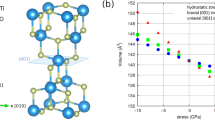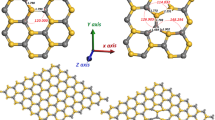Abstract
The effects of strain on the band gap and oxygen vacancy diffusion are investigated for the anatase (101) surface through density functional theory calculations. The results show that biaxial strain can effectively shift the band edge of the surface; for example, tensile strain gently reduces the band gap. With respect to the subsurface-to-surface diffusion of oxygen vacancy, energy barrier has a significant dependence on strain. As strain increases, it facilitates O-vacancy diffusion at the clean surface but hinders this migration for the reduced surface in the presence of water. Analysis based on the water adsorption energy indicates that the interplay between O-vacancy and water is weakened with increasing strain.




Similar content being viewed by others
References
Wang D et al (2009) ACS Nano 3:907–914
Han F et al (2009) Appl Catal A 359:25–40
Fujishima A (1972) Nature 238:37–38
Daghrir R, Drogui P, Robert D (2013) Ind Eng Chem Res 52:3581–3599
Chen X, Mao SS (2007) Chem Rev 107:2891–2959
Zhang Y et al (2010) ACS Nano 4:7303–7314
Xiang Q, Yu J, Jaroniec M (2012) J Am Chem Soc 134:6575–6578
Henderson MA (2002) Surf Sci Rep 46:1–308
Yang HG et al (2008) Nature 453:638–641
Yu J et al (2014) J Am Chem Soc 136:8839–8842
De Angelis F et al (2014) Chem Rev 114:9708–9753
Lazzeri M, Vittadini A, Selloni A (2001) Phys Rev B 63:155409
Sanches F et al (2014) Phys Rev B 89:245309
Selçuk S, Selloni A (2014) J Chem Phys 141:084705
Chen J et al (2013) J Am Chem Soc 135:18774–18777
Portillo-Vélez N et al (2013) Surf Sci 616:115–119
Labat F, Baranek P, Adamo C (2008) J Chem Theory Comput 4:341–352
Vittadini A et al (1998) Phys Rev Lett 81:2954
Sorescu DC et al (2011) J Chem Phys 134:104707
Lozovoi A et al (2014) J Chem Phys 141:044504
Liu L et al (2013) ChemPhysChem 14:996–1002
Linh NH et al (2015) Surf Sci 633:38–45
Zhang X et al (2014) Sci Rep 4:4762
Vittadini A, Selloni A (2002) J Chem Phys 117:353–361
Darkins R et al (2014) Phys Chem Chem Phys 16:9441–9447
Thulin L, Guerra J (2008) Phys Rev B 77:195112
Yin W-J et al (2010) Appl Phys Lett 96:221901
Aschauer U et al (2009) J Phys Chem C 114:1278–1284
Setvín M et al (2013) Science 341:988–991
Li Y, Gao Y (2014) Phys Rev Lett 112:206101
Blöchl PE (1994) Phys Rev B 50:17953
Perdew JP, Burke K, Ernzerhof M (1996) Phys Rev Lett 77:3865
Henkelman G, Uberuaga BP, Jónsson H (2000) J Chem Phys 113:9901–9904
Giannozzi P et al (2009) J Phys Condens Matter 21:395502
Landmann M, Rauls E, Schmidt W (2012) J Phys Condens Matter 24:195503
Martsinovich N, Jones DR, Troisi A (2010) J Phys Chem C 114:22659–22670
Sasaki T (2002) J Phys Condens Matter 14:10557
Shibata T, Irie H, Hashimoto K (2003) J Phys Chem B 107:10696–10698
Shu D-J et al (2008) Phys Rev Lett 101:116102
Simpson J et al (2004) Phys Rev B 69:193205
Cheng H, Selloni A (2009) Phys Rev B 79:092101
Setvin M et al (2014) Phys Rev Lett 113:086402
He Y et al (2009) Nat Mater 8:585–589
Finazzi E et al (2008) J Chem Phys 129:220–228
Acknowledgments
This work is supported by AFOSR (FA9550-12-1-0159). We also acknowledge support from DARPA (W91CRB-11-C-0112).
Author information
Authors and Affiliations
Corresponding authors
Rights and permissions
About this article
Cite this article
Zhang, Y., Hao, F., Liu, C. et al. Band gap and oxygen vacancy diffusion of anatase (101) surface: the effect of strain. Theor Chem Acc 135, 171 (2016). https://doi.org/10.1007/s00214-016-1916-7
Received:
Accepted:
Published:
DOI: https://doi.org/10.1007/s00214-016-1916-7




